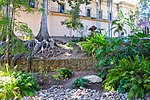San Diego Model Railroad Museum
AC with 0 elementsBalboa Park (San Diego)Institutions accredited by the American Alliance of MuseumsLibraries in San DiegoModel railroads ... and 5 more
Model railway shows and exhibitionsMuseums in San DiegoRailroad museums in CaliforniaResearch librariesResearch libraries in the United States

The San Diego Model Railroad Museum is a model railroad exhibit in San Diego, California. At 27,000 sq. ft., it is the largest such indoor exhibit in North America, and one of the largest in the world. The museum is on the lower level of the Casa de Balboa Building on the Prado in Balboa Park. The museum is open Thursday - Sunday from 11 a.m. - 4 p.m. .Nearly three million people have passed through the center since it opened in 1982.The San Diego Model Railroad Museum is a 501(c)(3) organization non profit charity.
Excerpt from the Wikipedia article San Diego Model Railroad Museum (License: CC BY-SA 3.0, Authors, Images).San Diego Model Railroad Museum
El Prado, San Diego Banker's Hill
Geographical coordinates (GPS) Address Nearby Places Show on map
Geographical coordinates (GPS)
| Latitude | Longitude |
|---|---|
| N 32.731111111111 ° | E -117.14777777778 ° |
Address
Zoro Garden
El Prado
92134 San Diego, Banker's Hill
California, United States
Open on Google Maps











